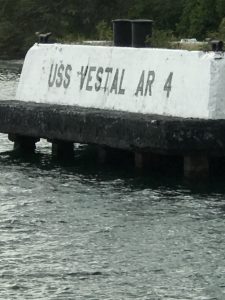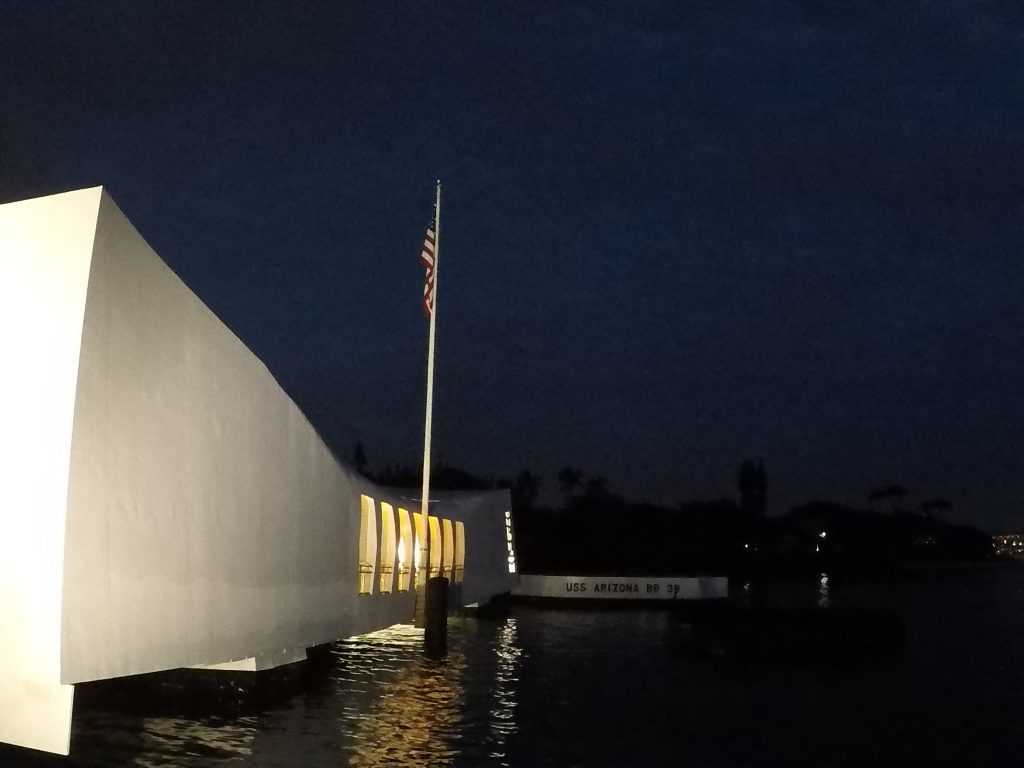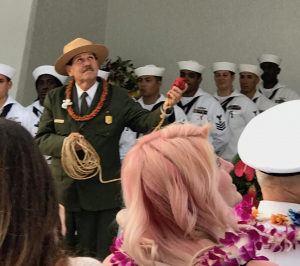On December 7, 1941, Chief Boatswain’s Mate Joseph Leon George was serving on the repair ship, USS Vestal, which was moored inboard to the USS Arizona at Ford Island. The plan was for the sailors of the USS Vestal to perform routine maintenance and upkeep on the USS Arizona from December 6 through December 12, 1941, to prepare her for new sorties into the Pacific in an attempt to deter the Japanese from further aggression. On Friday, December 5, Chief George participated in a boxing match in Honolulu and ended up in another altercation that earned him a court-martial for his behavior with a sentence of forced confinement to the ship for the foreseeable future. The scheduled repair work began on Saturday, December 6, 1941, and was proceeding as expected when the Japanese attack commenced at 7:55 am on Sunday, December 7. At six minutes after 8, an armor-piercing bomb cut through five decks and detonated in the powder magazine of the USS Arizona. The explosion instantly killed 1,177 young men and left others like Lauren Bruner, Donald Stratton, Harold Kuhn, Alvin Dvorak, Earl Riner, and Ronnie Lott fighting for their lives. These men burned, made their way to the Fire Control Tower and fought for their lives although all had blisters over at least 60% of their bodies from the flames. In the tower, they noticed a burly sailor on the USS Vestal diligently cutting the ropes that held the USS Arizona fast to get the Vestal underway. That sailor, Chief Boatswain’s Mate Joseph Leon George, was unknown to the six survivors for almost six decades.
 Chief George was working to put the fires out on board the USS Vestal when using his own words from an oral history interview with the University of North Texas from 1978. After Donald Stratton and the stranded sailors of the USS Arizona yelled and got his attention that morning, Chief George stated to the interviewer, “I was on the superstructure deck, and that was up in the area where the silvering shop was. That part of the deck was about the only part of the deck that was even with the Arizona. The Arizona, although her main deck was maybe lower than ours, she drew more water. But at the particular place that these people were trying to get over, they were surrounded by fire on the Arizona. This was on the superstructure deck where the Vestal was in correspondence with the level and height of the Arizona. They were stranded on the ship, and they were trying to get off, and they was surrounded by fire.” When the interviewer asked him how many people got off the ship over the line, Chief George stated, “I’ll tell you, I didn’t wait to see because I secured it on my ship as tight as I could. They fore-handed themselves over, because I couldn’t help them. I went on about my business.” In the oral history, Chief George seemed to think that what he did was not that big of a deal, but to the six men he saved, his valor was extraordinary.
Chief George was working to put the fires out on board the USS Vestal when using his own words from an oral history interview with the University of North Texas from 1978. After Donald Stratton and the stranded sailors of the USS Arizona yelled and got his attention that morning, Chief George stated to the interviewer, “I was on the superstructure deck, and that was up in the area where the silvering shop was. That part of the deck was about the only part of the deck that was even with the Arizona. The Arizona, although her main deck was maybe lower than ours, she drew more water. But at the particular place that these people were trying to get over, they were surrounded by fire on the Arizona. This was on the superstructure deck where the Vestal was in correspondence with the level and height of the Arizona. They were stranded on the ship, and they were trying to get off, and they was surrounded by fire.” When the interviewer asked him how many people got off the ship over the line, Chief George stated, “I’ll tell you, I didn’t wait to see because I secured it on my ship as tight as I could. They fore-handed themselves over, because I couldn’t help them. I went on about my business.” In the oral history, Chief George seemed to think that what he did was not that big of a deal, but to the six men he saved, his valor was extraordinary.
For 60 years, the man who saved those six men was forgotten to history, but not to Donald Stratton, Lauren Bruner, or their families. Once the Strattons determined that Chief Boatswain’s Mate Joseph Leon George saved Donald’s life with the timely throw of a monkey fist, they worked tirelessly to see him recognized for his valorous actions of that day. It took 16 years, and plenty of pushback from the United States Navy before a July 2017 trip to Washington by Donald Stratton, Lauren Bruner, and Ken Potts resulted in recognition at last. The US Senate not only passed a resolution recognizing Chief George, but the US Navy awarded the Bronze Star with V Device for Valor to him for his actions that day.

During the ceremony, Chief Historian Daniel Martinez looks skyward with the monkey fist. Donald Stratton’s Granddaughter Nikki is in the foreground.
On December 7, 2017, there was a ceremony on the USS Arizona Memorial that posthumously presented the Bronze Star with V for Valor device to Chief Boatswain’s Mate Joseph Leon George for his valiant rescue of six crewmembers of the burning USS Arizona on December 7, 1941. Lauren Bruner, Donald Stratton, and Louis Conter, three of the five remaining USS Arizona Survivors along with Joeann Taylor, Chief George’s daughter, attended the ceremony honoring Chief George’s selfless act. The ceremony left those in attendance with a more palpable understanding of the horrors witnessed that fateful day, 76 years ago. A sailor who thought his action was nothing more than doing what he had to do on that day when men and women of all colors, nationalities, and repute just did what they had to do to handle that crisis. It is these stories that are the most meaningful to me because they show out of extraordinary emergencies, ordinary people can rise and overcome harrowing experiences that through the lens of history look insurmountable. Time and again history has taught us that these ordinary men, women, and children can be found doing what is required at times like December 7, 1941; September 11, 2001; and even February 14, 2018. For me, the ceremony to honor Chief Boatswain’s Mate Joseph Leon George also honored all the men and women of the Greatest Generation who overcame the incredible odds that were the Great Depression and World War II to lead the United States to victory. I am very thankful that the Strattons and the Taylors allowed me to attend this very moving ceremony, and the challenge coin that they presented me will always remind me of the heroism shown by all the men and women who lived through the hell that was Pearl Harbor on December 7, 1941.
Watch the ceremony and feel the power of the event.


Well done Stan! You honored Joe George, his family and the men he saved through your words and the profound respect you have for the Greatest Generation.